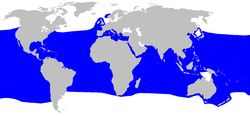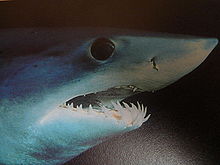Shortfin mako shark
| Shortfin mako shark | |
|---|---|

| |
| Scientific classification | |
| Kingdom: | |
| Phylum: | |
| Class: | |
| Subclass: | |
| Order: | |
| Family: | |
| Genus: | |
| Species: | I. oxyrinchus
|
| Binomial name | |
| Isurus oxyrinchus Rafinesque, 1810
| |

| |
| Range of shortfin mako shark (in blue) | |
The shortfin mako shark, Isurus oxyrinchus ("sharp nose"), is a large shark of the Lamnidae family. Along with the closely related longfin mako, Isurus paucus, it is commonly called just mako shark.
Anatomy and appearance

This species has an average full-grown length of 1.82–2.8 m (6–9.2 ft)[2][3] and weight of approximately 200 kg (440 lb). The largest reported mako was said to be 1,000 kg (2,200 lb) and 4 m (13.2 ft), although the largest confirmed size is 3.96 m (13 ft) and 794 kg (1,750 lb).[4] It has a bluish back and white underside. Although the sexes grow at about the same rate, females are thought to have a longer life span, and grow larger and weigh more than the males. Shortfin makos are renowned for their speed and their ability to leap out of the water. In fact, there are cases when an angry mako will jump out of the water and into the boat after it has been caught on the hook. Mako sharks have a better hydrodynamic shape than all other sharks, and this, combined with the lamnidae's typical high aerobic muscle mass, reflects in the spectacular speed and agility of both the longfin and shortfin makos[citation needed].
The shortfin mako shark is a sleek spindle shaped shark with a long conical snout. This shark has short pectoral fins and a crescent shaped caudal (tail) fin. There is a distinct caudal keel on the caudal base. Its second dorsal fin is much smaller than the first. The teeth are slender and slightly curved with no lateral cusps, and are visible even when the mouth is closed. There is marked countershading on this shark: dorsally it is a metallic indigo blue while ventrally it is white.
Naming
The name "mako" comes from the Māori language,[5] meaning either the mako shark or a shark tooth. It may simply have originated from a dialectal variation as it is similar to the common words for shark in a number of Polynesian languages - makō in the Kāi Tahu Māori dialect,[6] mangō in other Māori dialects,[6] ma'o in Tahitian, and mano in Hawaiian. The first written usage is in Lee & Kendall's Grammar and vocabulary of the language of New Zealand (1820), which simply states "Máko; A certain fish".[7][8] Richard Taylor's A leaf from the natural history of New Zealand (1848) is more elaborate: "Mako, the shark which has the tooth so highly prized by the Maoris".[9]
Diet
The shortfin mako feeds mainly upon bony fishes including mackerels, tunas, bonitos, and swordfish, but may also eat other sharks, porpoises, sea turtles, and herons. In Ganzirri and Isola Lipari, Sicily, shorfin makos have been found with amputated swordfish bills impaled into thier head and gills, suggesting makos are making the swordfish a major food source during late spring, early summer---coressponding to the swordfish's spawning cycle. This shark like others has a natural preditorial instinct to attack prey while they are most vulnerable.[10]
Distribution
The shortfin mako is found in offshore temperate and tropical seas worldwide. The closely related longfin mako shark, Isurus paucus, is found in the Gulf Stream or warmer offshore waters.
They are a pelagic species that can be found from the surface down to depths of 150 m or 490 ft. The shortfin mako is found in blue waters normally far from land occasionally closer to shore, particularly around islands or inlets.[10] This shark is seldom found in waters colder than 16° C (61° F).
In the western Atlantic it can be found from Argentina and the Gulf of Mexico to Browns Bank off of Nova Scotia. In Canadian waters these sharks are not abundant as they prefer warm waters, but neither are they rare. Shortfin makos are often found in the same waters as swordfish as they are a source of food and both fish prefer similar environmental conditions.
Behavior
The shortfin mako shark's speed has been recorded at 50 km/h (31 mph) and there are reports that it can achieve bursts of up to 74 km/h (46 mph).[11] Shortfin makos can jump up to 9 m (28 ft) in the air. Due to its speed and agility, this high-leaping fish is sought as game worldwide. This shark is highly migratory. They are also one of four warm-blooded sharks which helps them swim fast.
There is still some uncertainty about its life-span, but it is suspected to reach ages of between 11 to 23 years.
Reproduction
The shortfin mako shark is a yolk-sac ovoviviparous shark, meaning it gives birth to live young who feed from a sac full of yolk in the womb. The gestation period for a mako shark is 15 to 18 months. Shortfin mako embryos in the female's body consume each other to get nutrients. This is called intrauterine cannibalism.
Female shortfin makos usually become sexually mature at a length of 3 m. Developing embryos feed on unfertilized eggs in the uterus during the gestation period of 15 to 18 months. The 4 to 18 surviving young are born live in the late winter and early spring at a length of about 70 cm, but have no placental connection during development (ovoviviparity). It is believed that females may rest for 18 months after birth before the next batch of eggs are fertilized.
Male shortfin makos reach sexual maturity within 4 years.
Distinguishing characteristics
- Teeth are visible even when the mouth is closed
- Teeth are long and slender with smooth-edged cusps
- Distinct countershading, dorsally blue and ventrally white
- Moderately short pectoral fins
- Underside of the snout is white
Captivity
Of all recorded attempts to keep pelagic shark species in captivity, the Mako has fared the poorest; even more so than the oceanic whitetip shark, the blue shark and the great white shark. The current record is held by a specimen that, in 2001, was kept at the New Jersey Aquarium for only five days. Like past attempts at keeping Isurus in captivity, the animal appeared strong upon arrival but had trouble negotiating the walls of the aquarium, refused to feed, quickly weakened and expired.[12]
Attacks on humans
The shortfin mako[13] does have a formidable and foreboding appearance. The ISAF statistics on attacking species of sharks purports that the shortfin mako has had eight unprovoked attacks on humans with two ending in fatality and twenty boat attacks.[14]
Mako sharks in popular culture
- Three genetically engineered mako sharks are the chief antagonists of 1999 science fiction/horror film Deep Blue Sea.
- A female mako shark also starred in Mathias Bradley's novel, Mako: Journey of Discovery as the human-friendly Sunyui. In the sequel, Mako: Journey of Discovery 2: Sunyui's Family, Sunyui becomes the main star at SeaWorld, Japan, along with her mate, Rio. In the end, Sunyui mates with Rio and she has two litters of three pups during her two pregnancies.
- A mako shark is also seen on Jackass 2:The Movie, Steve-O kicks one in the head while being used as human bait in a skit.
- A mako shark appeared in Ernest Hemmingway's novella, The Old Man and The Sea
- A character from the series Dino-Riders is named Mako, but he resembles a hammerhead shark.
- Mako sharks were mentioned in Life of Pi, by Yann Martel.
- Mako sharks are common around Mako Island; the fictional island from the Nickelodeon series H2O: Just Add Water, where the girls first gain their powers and mermaid tails.
- In the Pixar film Finding Nemo, the character, Chum, is a mako shark.
- Mako sharks can be kept in an aquarium in the computer game Zoo Tycoon.
- In the movie The Perfect Storm, the crew of the Andrea Gail catch a mako whilst fishing in the Flemish Cap.
Notes
- ^ "More oceanic sharks added to the IUCN Red List" (Press release). IUCN. 2007-02-22. Retrieved 2007-02-25.
The global threat status was heightened for shortfin mako, a favorite shark among commercial and recreational fishermen, from Near Threatened in 2000 to Vulnerable today.
- ^ <http://www.sdnhm.org/kids/sharks/shore-to-sea/mako.html>
- ^ <http://animaldiversity.ummz.umich.edu/site/accounts/information/Isurus_oxyrinchus.html>
- ^ large shortfin makos
- ^ "Maori language - a glossary of useful words from the language of the Maori New Zealand". Retrieved 2006-08-11.
- ^ a b H.W.Williams (1971). Dictionary of the Maori Language (7th ed.).
- ^ Oxford: The Dictionary of New Zealand English: New Zealand words and their origins. 1997.
- ^ "Online Etymology Dictionary". Retrieved 2008-03-08.
- ^ Richard Taylor (1848). A leaf from the natural history of New Zealand. p. xiii.
- ^ a b "The Shark Gallery - Shortfin Mako Shark (Isurus oxyrinchus)". "The Shark Trust". Retrieved 2008-10-02.
{{cite web}}: Cite has empty unknown parameter:|1=(help) - ^ R. Aidan Martin. "Biology of the Shortfin Mako". ReefQuest Centre for Shark Research. Retrieved 2006-08-12.
- ^ Elasmobranch Research around Monterey Bay
- ^ Passarelli, Nancy. "SHORTFIN MAKO". Florida Museum of Natural History. Retrieved 2008-10-06.
{{cite news}}: Unknown parameter|coauthors=ignored (|author=suggested) (help) - ^ ISAF Statistics on Attacking Species of Shark
References
- Template:IUCN2006 Database entry includes justification for why this species is near threatened
- "Isurus oxyrinchus". Integrated Taxonomic Information System. 23 January.
{{cite web}}: Check date values in:|date=and|year=/|date=mismatch (help) - Froese, Rainer; Pauly, Daniel (eds.) (2006). "Isurus oxyrinchus" in FishBase. May 2006 version.

